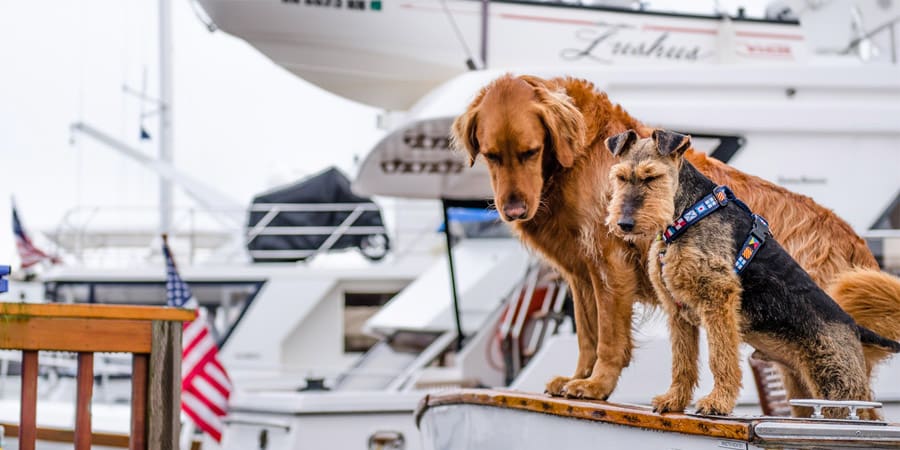You’re planning your perfect sailing holiday and don’t want to leave your four-legged friend behind? Don’t worry. Zizoo has put together all the information you need about sailing with cats and dogs in order to make your next sailing holiday an unforgettable experience for the whole family – human and otherwise. Because one thing is for sure: sailing with pets is not only possible, it’s fun!
Introduce your pet to the boat gradually
Introduce your pet to the boat gradually, starting with short trips and gradually increasing the duration of the trips. This will help your pet become accustomed to the motion of the boat. Familiarize your pet with the various sounds and smells of the boat. This can help reduce anxiety and stress during the trip.
Before you leave
Travel regulations for animals vary from country to country so make sure to inform yourself ahead of time about the necessary documentation as well as the regulations about animal quarantine in your chosen travel destination. It’s best to contact the local authorities for this information. With as many people opting for the different profiles of veterinary jobs available, you can get in touch with any one of them, and clear all your doubts, before you set to set to sail with your pet.
If you’re traveling in Europe, for example, you will need a pet passport which needs to be signed by an officially approved veterinary surgeon.
You should also make sure that your pet is microchipped, as this is a requirement in almost every country.
Take care to keep your pet’s vaccination record up to date and plan ahead if you think your pet might need additional vaccines.
Sailing with pets is easily done but it’s advisable to start planning early, as vaccines and applying for documentation can take a while.
Before booking a boat for your sailing holiday, ask your charter agency whether they welcome animals on board or whether you need to plan with certain extra costs.
Safety on board when sailing with pets
If your pet is active, and depending on weather conditions, it might be advisable to secure the outside of the boat with a net.
Furthermore, cats and dogs should always wear life jackets on board (as should their owners, of course).
You can also use a harness if it’s too warm outside for your animal to wear a vest. That way your pet will be more comfortable and you can still easily help it out of the water. You can get different harnesses for different dogs so make sure you get a suitable harness that fits securely. Check out www.jugdog.co.uk to look at the pros and cons of various harnesses.
When choosing a pet flotation device, there are a few things you should consider:
- Size: Make sure the flotation device fits your pet properly. It should be snug enough to stay in place, but not so tight that it restricts movement or causes discomfort.
- Buoyancy: The flotation device should provide enough buoyancy to keep your pet afloat in the water.
- Visibility: Choose a flotation device that is brightly colored or has reflective strips, so your pet is easy to spot in the water.
- Durability: The flotation device should be made of high-quality materials that can withstand rough conditions.
- Ease of use: Look for a flotation device that is easy to put on and take off, and that has adjustable straps to ensure a secure fit.
- Comfort: Make sure the flotation device is comfortable for your pet to wear.
Toilet
Going to the toilet on the high seas can be especially tricky for dogs. Think about constructing a special dog toilet, like a patch of fake lawn or a cat toilet filled with sand.
Try and acquaint your dog with this new technique at home, so it will feel comfortable from the minute it sets foot on board.
If you think this isn’t an option for your pet, plan shorter sailing trips of around 3-5 hours so that your dog can comfortably go on land. Even though cats have it significantly easier, please remember that you should place the cat toilet below deck where it is more stable.
Sun protection and sea sickness
Animals can get seasick on a sailing holiday, just like us humans. Make sure that there are always enough shaded areas onboard for your pet to take a rest, and that there is always fresh water available.
It’s easier on your pet’s stomach if you halve food portions. There are many remedies available (even from human medicine) should your four-legged friend still become sick. Ask your favorite vet about putting together a little first-aid kit!
Further tips for sailing with pets
Playing on the beach and in the water can be a real treat, especially for dogs. But remember that even on board, when the rest of the family is relaxing in the sun, your little one shouldn’t be allowed to get bored.
So pack enough toys and make sure that your pet is always occupied.
Create a little personal corner on the boat where your cat or dog can feel safe if they want to relax during your sailing holiday. Put some blankets or toys from home in this corner, so that your pet will feel as comfortable as possible.
